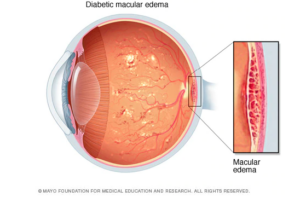Understanding Diabetic Macular Edema (DME)
For people with diabetes, it is important to stay on top of their health and well-being. If left unchecked, diabetes can lead to many health problems including eye disease.
In fact, diabetes is the leading cause of new blindness in the U.S. Diabetic retinopathy is a complication of diabetes and the most common diabetic eye disease. It is the leading cause of irreversible blindness in working-age Americans and usually affects both eyes.
A condition known as diabetic macular edema (DME) can contribute significantly to these increased levels of blindness. It is the most common cause of vision loss in people with diabetic retinopathy. DME can happen to people with either type 1 or type 2 diabetes by damaging blood vessels in the retina.
What is DME?

If blood vessels in the retinal area of the eye are negatively affected, diabetics can develop a condition called diabetic macular edema (DME). In fact, DME is a condition that affects up to half of all people with diabetic eye disease.
DME can occur when blood vessels leak in the retina leak fluid and cause the macula to swell. The macula is the central part of the retina and controls sharp vision. For people with DME, vision loss can take many months and make it difficult to focus clearly.
Some symptoms of DME include:
- Blurry or wavy vision
- Double vision
- Washed out colors
- A rise in eye floaters
Diabetics looking to avoid DME must make efforts to control their blood sugar levels. This is because high blood sugar levels can weaken and cause damage to blood vessels in the retina.

Additional risk factors for DME include:
- Having diabetes for a longer period of time
- Type 1 or Type 2 diabetes. Over two decades, almost everyone with type 1 diabetes and 60% of type 2 diabetics will develop some form of diabetic retinopathy.
- Abnormally high blood pressure
- Retaining fluid
- Kidney disease
- Hyperlipidemia
- Pregnancy
Thankfully, managing diabetes effectively is one of the best ways for diabetics to reduce their risk of eye disease.
Reducing Risk of DME

People with diabetes can reduce their risk of developing DME by managing their condition effectively. These efforts should include:
- Controlling blood sugar levels
- Maintaining healthy blood pressure
- Obtaining healthy cholesterol levels
Eating a healthy diet focused on diabetic-friendly foods is a great way to reduce DME risk. Eye-friendly foods such as dark, leafy greens and fish rich in omega-3’s are good options. Staying active and moving is also critically important for people with diabetes. Although it may not seem like it, these healthy habits can be very beneficial for your eyes.
Additionally, diabetics should regularly visit their doctors and get annual eye exams to prevent serious eye problems from developing. Your eye doctor can consult with you and discuss ways to develop effective treatments for your unique situation.
Treatments for DME

Treatments for DME vary and depend on each person’s condition. Sometimes lasers are used to close and eliminate blood vessels that may be leaking in the eye. This can help slow or stop the growth of new blood vessels that could damage a person’s vision even more. However, laser treatments could leave permanent blind spots in a person’s vision.
Anti-vascular endothelial growth factor (anti-VEGF) drugs can also be utilized for treating DME. They can block new blood vessels from developing and inhibit leakage in the eye. Multiple injections are needed for this treatment to be effective and will vary depending on each individual case.
Steroids can also be injected into a patient’s eye to reduce DME and boost vision. These steroids are sometimes injected into a steroid eye implant to release the drug over time.